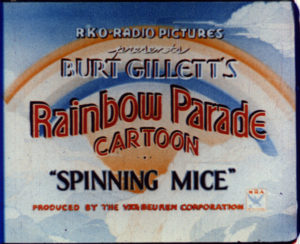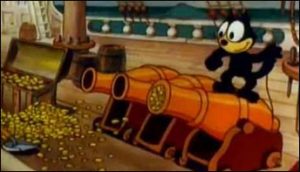 The 1935-36 season was good to RKO and good to all its suppliers. The Van Beuren cartoons had demonstrated considerable improvement over anything from the preceding few seasons, and it didn’t hurt that they were all in color – moving from Cinecolor to full Technicolor. Furthermore, Van Beuren would make deals to get rights to well-known characters, either from comic strips (Toonerville Folks) or the still well-remembered Felix the Cat.
The 1935-36 season was good to RKO and good to all its suppliers. The Van Beuren cartoons had demonstrated considerable improvement over anything from the preceding few seasons, and it didn’t hurt that they were all in color – moving from Cinecolor to full Technicolor. Furthermore, Van Beuren would make deals to get rights to well-known characters, either from comic strips (Toonerville Folks) or the still well-remembered Felix the Cat.
Spinning Mice (4/5/35) – The Toddle Tale kids wonder about a collection of mice that chase their tails and spin on their noses. One of the mice explains to the kids why they spin, and then goes into a story about a kindly old alchemist who tries to improve on nature. His chemistry goes awry, producing devil imps who chase him all around the lab, and attempt to subject him to his own transformation potions. A pair of doves find an antidote, restoring all to original form. The alchemist shoos his subject mice and doves away to freedom, and vows to destroy his secrets and leave well-enough alone. Songs: “Leave Well Enough Alone”, an original, not to be confused with a later original from a Max Fleischer Popeye of the same name.
A Picnic Panic (5/3/35) – Another color Toddle Tale released as a Rainbow Parade. On a rainy day, the kids can’t go out on a picnic, but are serenaded by a whistling rea kettle, coffee pot, etc. simmering on the stove. Mr. Coffee Pot and his wife (a teapot) relate the story of the last picnic they went on with their crockery family. Molly Moo Cow makes her theatrical debut as a meddling bovine anxious to partake of the picnic lunch. The pot, cups and saucers wage war to repel her from the shindig. Song: “Rhythm of the Rain”, a catchy original, not to be confused with a song of the same title from Maurice Chevalier’s “Follies Bergere De Paris”.
The Merry Kittens (5/31/35) – This film manages to get through seven minutes or so without any reference at all to mittens. Three small kittens awaken and formulate plans for the day – primarily consisting of teasing the household dog. A lot of chasing, and a primary sequence where the dog gets completely wrapped up in a massive ball of yarn. He gets even by landing on a case of seltzer bottles, filling the kittens with seltzer water until they float from the carbonation around the room. The dog is finally released from the yarn when its strings are wound up by the blades of an electric fan, and the four share a mutual laugh. Song: “A Kitten’s Life Is a Merry One”, an original.
The Rag Dog (7/19/35) – A sequel to “The Merry Kittens”, featuring the same trio of juvenile cats, with the same voices. One additional cast member is added – a Scottie, who later would have a film of his own in “Scottie Finds a Home”. The kittens are still baiting the dogs, first with their milk from a bowl, then by taking all the stuffings out of a rag dog, climbing in, and chasing the dogs. At the end, they tell the dogs that if they’d asked, the kittens would have been glad to share their milk. Song: “Only a Dish of Milk”, another original.
Scotty Finds a Home (8/23/35) – The title almost tells you all you need to know about this cartoon. Scotty, after being rebuffed by a housewife, shows his worth, after he exposes a traveling hobo who is trying to horn in on the wife and family. Once the hobo has been vanquished, the housewife receives kisses from Scotty, and now seems to enjoy it. Songs: “I Wish I Had a Dog”, sung by the family kid, and “We’ll Play”, as the child and dog imagine games of pirate and other role-playing.
Molly Moo Cow and the Butterflies (11/15/35) – Molly is fascinated by a butterfly, and somehow rigs herself a pair of artificial butterfly wings. Her attempts at flight are rather ungainly, and short-lived. There is a butterfly hunter who seeks to capture various specimens, and mistakes Molly for a rare prize for his collection. The butterflies give the Van Beuren artists a real chance to display their full color palette, including a final scene where they show their appreciation for Molly’s assistance in evading the collector by draping her in multi-colors until she resembles a queen in fill raiment. Song: “Butterfly”, an original sung by the collector.
Molly Moo Cow and Rip Van Winkle (12/17-35) – Concentrates mainly on the aspect of the story of thunder being created by the mountain gnomes playing ninepin bowling (though the film seems to depict ten pins). One can only wonder where RKO got their excellent sound effects for this episode. Molly gets schnockered (or at least a little tipsy) on gnome ale, and tries her hoofs at bowling. It is not really known what her score was, but seems apparent it is nowhere near 300. Songs: “Drink to Rip Van Winkle”, an original song sung by the gnomes in tribute to the sleeping Rip in the glen nearby.
 Felix the Cat and the Goose That Lays the Golden Eggs (2/7/36) – Felix already has the goose at the opening, who lays eggs that roll into a slicer to be sliced into coins, which Felix is distributing all around via a charitable welfare relief station. Everyone is happy, except pirate Captain Kidd, who wants all the gold for himself. The pirate tries disguising himself as a frail old woman, but is immediately found out by Felix. Nevertheless, the pirate succeeds in absconding with “Goldie” the goose, taking her to his pirate ship. Felix resorts to a gag of the type one would have seen in his Pat Sullivan cartoons, as he converts his body into the shape of a cannon ball, and fires himself onto the deck of the pirate ship, where all heck breaks loose. Goldie is rescued, to the jubilation of all the neighboring folks, as Felix launches volleys of gold coins all around town by way of the ship’s cannons – proving there is nothing like investing in precious metal. Song: “We Take What We Want (and We Want What We Take)”, a chanty for the pirate crew.
Felix the Cat and the Goose That Lays the Golden Eggs (2/7/36) – Felix already has the goose at the opening, who lays eggs that roll into a slicer to be sliced into coins, which Felix is distributing all around via a charitable welfare relief station. Everyone is happy, except pirate Captain Kidd, who wants all the gold for himself. The pirate tries disguising himself as a frail old woman, but is immediately found out by Felix. Nevertheless, the pirate succeeds in absconding with “Goldie” the goose, taking her to his pirate ship. Felix resorts to a gag of the type one would have seen in his Pat Sullivan cartoons, as he converts his body into the shape of a cannon ball, and fires himself onto the deck of the pirate ship, where all heck breaks loose. Goldie is rescued, to the jubilation of all the neighboring folks, as Felix launches volleys of gold coins all around town by way of the ship’s cannons – proving there is nothing like investing in precious metal. Song: “We Take What We Want (and We Want What We Take)”, a chanty for the pirate crew.
Next Time: Wrap up on Van Beuren, and on to a new studio.


 James Parten has overcome a congenital visual disability to be acknowledged as an expert on the early history of recorded sound. He has a Broadcasting Certificate (Radio Option) from Los Angeles Valley College, class of 1999. He has also been a fan of animated cartoons since childhood.
James Parten has overcome a congenital visual disability to be acknowledged as an expert on the early history of recorded sound. He has a Broadcasting Certificate (Radio Option) from Los Angeles Valley College, class of 1999. He has also been a fan of animated cartoons since childhood.












































“Spinning Mice”, as may be expected, makes abundant use of the nursery song “Three Blind Mice”. This tune was featured in a fair few cartoons of the mid-1930s, for example Universal’s “Three Lazy Mice” (1934), Iwerks’s “The Three Bears” (1935), and Disney’s “Three Blind Mouseketeers” — not to mention dozens of Three Stooges shorts.
“Molly Moo Cow and the Butterflies” is my favourite of the series, not only for its vibrant use of colour but also for its music. The butterfly collector’s song is so ineffably silly, I can’t help loving it. “Horse flies, shoe flies, bar flies and time flies, but I’m at my best when I’m in a nest of butterflies!”
When Molly is dancing with the butterfly, we hear the waltz tune from the overture to Johann Strauss’s operetta “Die Fledermaus”. This work, complete and uncut, would later serve as the soundtrack to an Oscar-winning Tom and Jerry cartoon. Its title is German for “The Bat” — the hero of the operetta wears a bat costume to a masquerade ball — but I wonder if it ever occurred to Sharples to use another famous waltz, the “Valse des rayons”, from Offenbach’s ballet “Le papillon”, which is French for “The Butterfly”. That waltz, however, had become associated with the violent Apache dance routine at the Moulin Rouge; and while having the two butterflies do an Apache dance on that little stage under the coloured lights would have been a hilarious in-joke for ballet lovers; it wouldn’t have worked in the context of the cartoon. Butterflies aren’t really into rough lovemaking. It’s not like they’re praying mantises or black widow spiders.
Seeing all these Rainbow Parades in a row, it really makes me understand why RKO decided to cut out the middleman and just strike a deal with Walt Disney outright. Obviously, that worked out well for RKO, as far as I know. Van Beuren wasn’t as lucky.
However, I will concede that being allowed to make new Felix the Cat cartoons, in color no less, did give them a temporary new lease on life. It was just too little, too late, I suppose.
Nevertheless, I await the next studio subjected to this music session.
Van Beuren may no longer have been willing to pay for copyrighted songs to use, but the music at the very beginning of the live-action footage in “A Picnic Panic” is a close copy of “Singin’ in the Rain,” which had been a tremendous hit six years before in MGM’s “Hollywood Revue of 1929.”